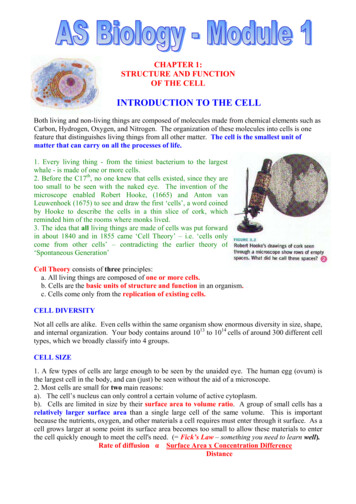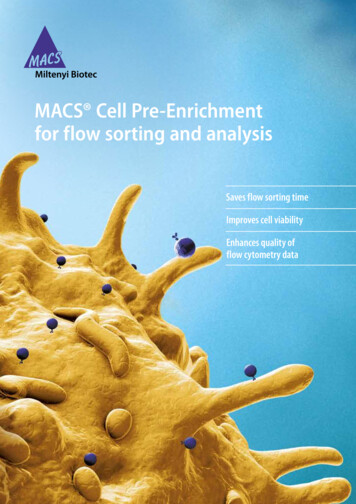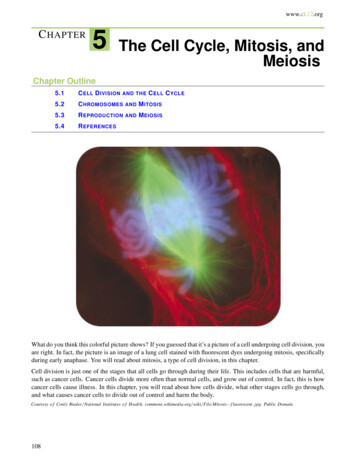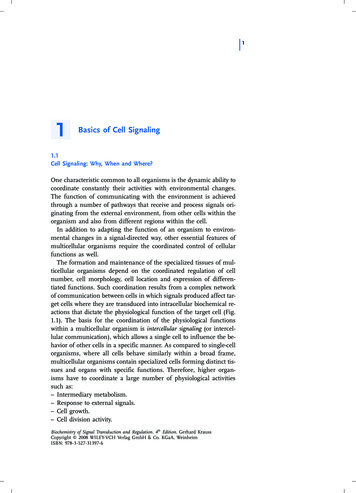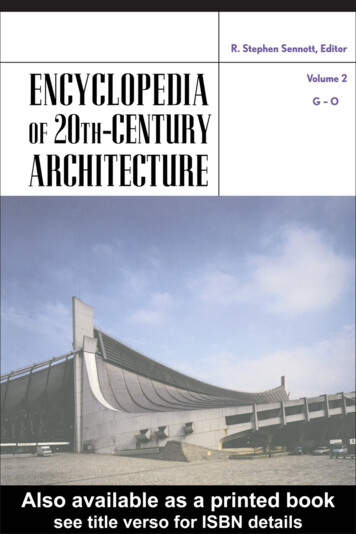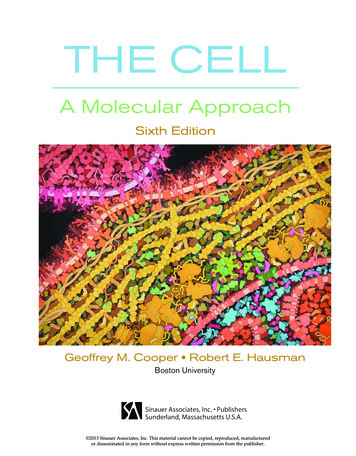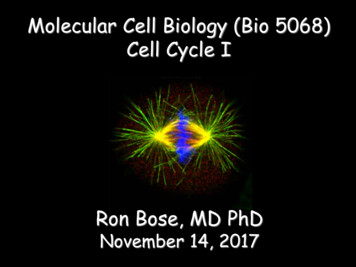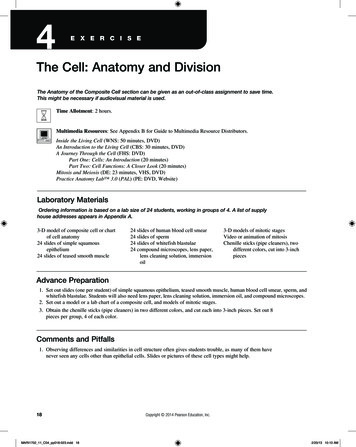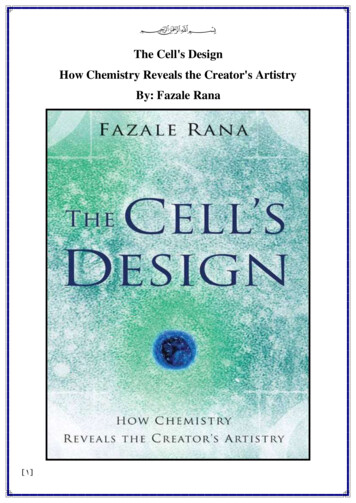
Transcription
The Cell's DesignHow Chemistry Reveals the Creator's ArtistryBy: Fazale Rana]1[
خ : نبذة ُمترصة عن الكتاب . أهم ُكتُب «فازل "فضل" رنا» عىل اإلطالق ّ من َّ ولو ،» أهم املؤ َّلفات يف جماله بعد كتاب «صندوق داروين األسود» لـ «مايكل بيهي » أن كتاب «بيهي ّ الكتاب ُيعترب َّ َّإَّل ، ُمهتم أكثر بنقد الدَّ اروينية . أن كتاب «تصميم اخللية» ُمهتم أكثر ببيان أد َّلة التَّصميم يف اخللية َّ ،» املؤ ِّلف يعرتف بفضل كتاب «مايكل بيهي» يف تعميم فكرة «التَّعقيد غري القابل لالختزال وأن مثل هذه األنظمة َّ إن هذه امليزة ليست وحدها الدَّ ا َّل ة عىل التَّصميم َّ ولكنَّه يقول ، دليل واضح عىل َّأَّنا نِتاج تصميم ذكي وإنَّام ، الذكي . ُهناك عرشا ت األد َّلة األخرى عىل التَّصميم يف اخللية جمايل األحياء ّ فهو أنفع ملن له خلفية علمية يف ، بسبب احتواء الكتاب عىل الكثري من التَّفاصيل العلمية الدَّقيقة َّ ، ومع ذلك ، والكيمياء . عوام الباحثني أمثايل يستطيعون حتصيل فوائد مجَّة وكثرية من الكتاب رغم ثِ َقل ما َّدته ّ فإن وأنصح عىل األقل بقراءة هذه ال ُف ُصول بشكل ، مع الفصل األول واألخري ُهم ُخالصة هذا الكتاب ، املُقدَّ مة . مع تص ُّفح هذا العصري ، كامل Introduction: A Rare Find Theists and atheists alike can see design in biological and biochemicalsystems. Even the well-known evolutionary biologist Richard Dawkins, anoutspoken atheist, acknowledges that “biology is the study of complicatedthings that give the appearance of having been designed for a purpose.”[Richard Dawkins, The Blind Watchmaker: Why the Evidence of EvolutionReveals a Universe without Design (New York: Norton, 1996), 1.] [FazaleRana: The Cell's Design (How Chemistry Reveals the Creator's Artistry)(Kindle Locations 158-160). Baker Books. Kindle Edition.] The late Francis Crick, who shared the Nobel Prize for discovering thestructure of DNA, cautioned, “Biologists must constantly keep in mind thatwhat they see was not designed, but rather evolved.”5 So even though life’schemistry looks as if it’s the product of a Creator, many in the scientificcommunity suppress this obvious intuition. [Francis Crick, What Mad]2[
Pursuit (New York: Basic Books, 1988), 138.] [Fazale Rana: The Cell'sDesign (How Chemistry Reveals the Creator's Artistry) (Kindle Locations165-167). Baker Books. Kindle Edition.] As biochemists learn more about the details of the cell’s chemical systems,the appearance of design becomes increasingly pervasive and profound.Currently, hundreds of scientists who represent a range of scientificdisciplines express skepticism about “the ability of random mutation andnatural selection to account for the complexity of life.”6 This skepticismlargely fuels the recent resurgence of the creation (intelligentdesign)/evolution controversy in America. [“A Scientific Dissent load.php?command download&id 660.] [Fazale Rana: The Cell'sDesign (How Chemistry Reveals the Creator's Artistry) (Kindle Locations172-176). Baker Books. Kindle Edition.] According to Behe, irreducible complexity describes “a single systemcomposed of several well-matched interacting parts that contribute to basicfunction, wherein removal of any one of the parts causes the system toeffectively cease functioning.” [Behe, Darwin’s Black Box, 39.] [FazaleRana: The Cell's Design (How Chemistry Reveals the Creator's Artistry)(Kindle Locations 181-183). Baker Books. Kindle Edition.] The case for intelligent design made in Darwin’s Black Box is compelling.Still, Behe’s explanation rises and falls on the perceived validity of theconcept of irreducible complexity. Several scientists have leveled significantchallenges against this argument.8 And, even though Behe has responded tothese critics, many skeptics remain unconvinced.9 [8. For example, Bruce H.Weber, “Biochemical Complexity: Emergence or Design?” Rhetoric &Public Affairs 1 (1998): 611–16; Philip Kitcher, “Born-Again Creationism,”in Intelligent Design Creationism and Its Critics: Philosophical, Theologicaland Scientific Perspectives, ed. Robert T. Pennock (Cambridge, MA: MITPress, 2001), 257–87; Matthew J. Brauer and Daniel R. Brumbaugh,“Biology Remystified: The Scientific Claims of the New Creationists,” inIntelligent Design Creationism and Its Critics, 289–334. 9. Michael J. Behe,William A. Dembski, and Stephen C. Meyer, Science and Evidence for]3[
Design in the Universe (San Francisco: Ignatius, 2000), 133–49.] [FazaleRana: The Cell's Design (How Chemistry Reveals the Creator's Artistry)(Kindle Locations 190-192). Baker Books. Kindle Edition.] In many respects, Behe pioneered the biochemical case for intelligent designin Darwin’s Black Box. The Cell’s Design continues this exploration andstrives to make the biochemical case for a Creator much more compelling.[Fazale Rana: The Cell's Design (How Chemistry Reveals the Creator'sArtistry) (Kindle Locations 208-210). Baker Books. Kindle Edition.] In most works of this nature, the authors are quick—perhaps too quick—todeclare the inability of evolutionary processes to produce certain features ofthe biological realm. Their argument goes something like this: “If evolutioncan’t produce it, then a Creator must have.” The Cell’s Design avoids thisnegative approach. Instead of focusing on what evolution can or cannot do,this book emphasizes the aspects of biochemical systems that make a positivecase for intelligent design. [Fazale Rana: The Cell's Design (How ChemistryReveals the Creator's Artistry) (Kindle Locations 217-221). Baker Books.Kindle Edition.] The technical terminology that is so much a part of cell biology andbiochemistry can feel overwhelming for many people. So, the details havebeen limited to those necessary to show the Creator’s fingerprints. However,the Creator’s signature style is ultimately most evident in the finer points ofthe cell’s chemistry. Please keep in mind, that for an Artist’s work to be fullyappreciated, one must take the time to study its subtleties and nuances.[Fazale Rana: The Cell's Design (How Chemistry Reveals the Creator'sArtistry) (Kindle Locations 231-234). Baker Books. Kindle Edition.]1 Masterpiece or Forgery? Philosopher Jay Richards and astronomer Guillermo Gonzalez point out intheir book The Privileged Planet that most individuals have no idea how theymake the distinction between an intelligently designed object and onegenerated by natural processes. They just intuitively do. [GuillermoGonzalez and Jay W. Richards, The Privileged Planet: How Our Place in theCosmos Is Designed for Discovery (Washington, DC: Regnery, 2004), 293–311.] [Fazale Rana: The Cell's Design (How Chemistry Reveals theCreator's Artistry) (Kindle Locations 268-270). Baker Books. Kindle]4[
Edition.] To properly reason from analogy, several factors must be considered: Therelevance of similarities is critical. The properties being compared must berelevant to the conclusion. The number of similarities that are part of theanalogy impacts the likeliness of the conclusion. The greater the number ofsimilarities the greater the validity of the conclusion. The number of events,objects, or systems that enter into the comparison influences the conclusion.The greater the number of separate comparisons, the more probable theconclusion. The diversity of the events, objects, or systems compared hasbearing on the conclusion. Greater diversity translates into greaterconfidence about the conclusion reached through comparison. Disanalogyis important. In addition to shared similarities—the ways in which the events,objects, or systems differ must be considered. [Fazale Rana: The Cell'sDesign (How Chemistry Reveals the Creator's Artistry) (Kindle Locations392-400). Baker Books. Kindle Edition.]2 Mapping The Territory The same year that Jan Vermeer painted The Artist’s Studio (1665), RobertHooke discovered cells.4 Following his initial work, a number of biologistsreported the existence of cells in plants and animals. These discoveriesculminated in the cell theory developed independently by Matthias Schleidenin 1838 and Theodor Schwann in 1839. This theory states that cells are thefundamental units of life and the smallest entities that can be considered“life.” As a corollary, all organisms consist of one or more cells. Most lifeforms on Earth are single-celled (bacteria, archaea, and protozoans).Multicellular organisms (plants, animals, and fungi) are made up ofspecialized cells that carry out the many activities necessary for life. [4.Details about the cell’s structural and chemical makeup can be found in anyintroductory biology textbook. For this chapter, the book consulted wasKaren Arms and Pamela S. Camp, Biology, 3rd ed. (Philadelphia: SaundersCollege Publishing, 1987).] [Fazale Rana: The Cell's Design (HowChemistry Reveals the Creator's Artistry) (Kindle Locations 461-466).Baker Books. Kindle Edition.] By the mid-1950s, biologists recognized two fundamentally distinct celltypes: eukaryotic and prokaryotic. Eukaryotic cells contain a nucleus,]5[
organelles, and internal membrane systems. Unicellular protists andmulticellular fungi, plants, and animals are examples of eukaryoticorganisms. Prokaryotic cells are typically about one micron in diameter.These cells appear to be much simpler than eukaryotic cells. Apart from acell boundary, prokaryotes lack any visible defining features. They don’thave a nucleus, organelles, or internal membranes. Their genetic materialconsists of “naked” highly coiled DNA that resides in the cytoplasm.Bacteria and archaea are prokaryotic organisms. Archaea are similar tobacteria in appearance, but fundamentally differ in their biochemicalmakeup. [Fazale Rana: The Cell's Design (How Chemistry Reveals theCreator's Artistry) (Kindle Locations 472-478). Baker Books. KindleEdition.]4 Such A Clean Machine Motors and machines are found not only under the hoods of automobiles.They are also found inside of cells. One of the most remarkable advances inbiochemistry during the last part of the twentieth century has been therecognition that many biochemical systems function as molecular-levelmachines. Remarkably, some of these biomolecular motors bear an eerieresemblance to humanly designed engines. Yet, these biomachines are farsuperior in construction and operation than their man-made counterparts.Biomachines make a powerful case for biochemical intelligent design andreinvigorate one of history’s most well-known arguments for a Creator’sexistence: the Watchmaker argument popularized in the eighteenth centuryby William Paley, a British theologian. [Fazale Rana: The Cell's Design(How Chemistry Reveals the Creator's Artistry) (Kindle Locations 984989). Baker Books. Kindle Edition.] The bacterial flagellum has become the “poster child” for Intelligent Design.3The flagellum looks like a whip and extends from the bacterial cell surface.Some bacteria have only a single flagellum, others possess several. Rotationof the flagellum(a) allows the bacterial cell to navigate its environment inresponse to various chemical signals. [Michael J. Behe, Darwin’s Black Box:The Biochemical Challenge to Evolution (New York: Free Press, 1996), 69–73.] [Fazale Rana: The Cell's Design (How Chemistry Reveals the Creator'sArtistry) (Kindle Locations 997-1000). Baker Books. Kindle Edition.]]6[
An ensemble of over forty different kinds of proteins makes up the typicalbacterial flagellum. These proteins function in concert as a literal rotarymotor. The bacterial flagellum’s components stand as direct analogs to theparts of a man-made motor, including a rotor, stator, drive shaft, bushing,universal joint, and propeller.4 The bacterial flagellum is essentially amolecular-sized electrical motor. The flow of positively charged hydrogenions through the bacterial inner membrane powers the flagellum’s rotation.5As research continues on the bacterial flagellum, its machinelike characterbecomes increasingly evident.6 [(October 1995): 489–520. 5. David F. Blair,“Flagellar Movement Driven by Proton Translocation,” FEBS Letters 545 (June 12, 2003): 86–95; Christopher V. Gabel and Howard C. Berg, “TheSpeed of the Flagellar Rotary Motor of Escherichia coli Varies Linearly withProtonmotive Force,” Proceedings of the National Academy of Sciences,USA 100 ( July 22, 2003): 8748–51. 6. For example, a cursory survey of theprestigious journal Nature over the last several years turns up the followingpapers: Scott A. Lloyd et al., “Structure of the C-Terminal Domain of FliG,a Component of the Rotor in the Bacterial Flagellar Motor,” Nature 400 (July 29, 1999): 472–75; William S. Ryu, Richard M. Berry, and Howard C.Berg, “Torque-Generating Units of the Flagellar Motor of Escherichia coliHave a High Duty Ratio,” Nature 403 ( January 27, 2000): 444–47; Fadel A.Samatey et al., “Structure of the Bacterial Flagellar Hook and Implication forthe Molecular Universal Joint Mechanism,” Nature 431 (October 28, 2004):1062–68; Yoshiyuki Sowa et al., “Direct Observation of Steps in Rotation ofthe Bacterial Flagellar Motor,” Nature 437 (October 6, 2005): 916–19.][Fazale Rana: The Cell's Design (How Chemistry Reveals the Creator'sArtistry) (Kindle Locations 1003-1008). Baker Books. Kindle Edition.] The rotary motor, F1–F0 ATPase, plays a central role in harvesting energy forcellular use.7 F1–F0 ATPase associates with cell membranes. Themushroom-shaped F1 portion of the complex extends above the membrane’ssurface. The “button of the mushroom” literally corresponds to an engineturbine. [Matti Saraste, “Oxidative Phosphorylation at the Fin de Siècle,”Science 283 (March 5, 1999): 1488–93.] [Fazale Rana: The Cell's Design(How Chemistry Reveals the Creator's Artistry) (Kindle Locations 10091013). Baker Books. Kindle Edition.]]7[
The rotary motor F1–F0 ATPase consists of a rotor, cam, turbine, and stator.The F1–F0 ATPase turbine interacts with the part of the complex that lookslike a “mushroom stalk.” This stalklike component functions as a rotor.8 Theflow of positively charged hydrogen ions (or in some instances sodium ions)through the F0 component embedded in the cell membrane drives the rotationof the rotor.9 A rod-shaped protein structure that also extends above themembrane surface performs as a stator. This protein rod interacts with theturbine holding it stationary as the rotor rotates. [8. Hiroyuki Noji, “TheRotary Enzyme of the Cell: The Rotation of F1-ATPase,” Science 282(December 4, 1998): 1844–45; William S. Allison, “F1-ATPase: AMolecular Motor that Hydrolyzes ATP with Sequential Opening and Closingof Catalytic Sites Coupled to Rotation of Its ã Subunit,” Accounts ofChemical Research 31 (December 1998): 819–26; Hiroyuki Noji andMasasuke Yoshida, “The Rotary Machine in the Cell, ATP Synthase,”Journal of Biological Chemistry 276 ( January 19, 2001): 1665–68. 9. VinitK. Rastogi and Mark E. Girvin, “Structural Changes Linked to ProtonTranslocation by Subunit c of the ATP Synthase,” Nature 402 (November18, 1999): 263–68; Joachim Weber and Alan E. Senior, “ATP SynthesisDriven by Proton Transport in F1–F0–ATP Synthase,” FEBS Letters 545 (June 12, 2003): 61–70; Wolfgang Junge and Nathan Nelson, “Nature’sRotary Electromotors,” Science 308 (April 29, 2005): 642–44.] [FazaleRana: The Cell's Design (How Chemistry Reveals the Creator's Artistry)(Kindle Locations 1016-1022). Baker Books. Kindle Edition.] The molecular motor myosin generates the force that produces musclecontraction and transports organelles throughout the cell. In contrast to thebiomotors just discussed, myosin is not a rotary motor. Rather, it’s a linearmotor with a rigid lever arm. Myosin also possesses a molecular hinge thatfunctions as a pivot point for the swinging lever arm (see figure 4.7).21Through genetic engineering and biophysical studies, researchers havedirectly (and indirectly) observed the swing of myosin’s lever arm and theswiveling of the myosin hinge.22 These measurements of the myosin motorin operation provide convincing proof of the swinging lever arm model formyosin motor function and myosin’s machinelike character. [21. Steven M.Block, “Fifty Ways to Love Your Lever: Myosin Motors,” Cell 87 (October18, 1996): 151–57; Roger Cooke, “The Actomyosin Engine,” FASEB]8[
Journal 9 (May 1995): 636–42. 22. For example, James D. Jontes, ElizabethM. Wilson-Kubalek, and Ronald A. Milligan, “A 32 Tail Swing in BrushBorder Myosin I on ADP Release,” Nature 378 (December 14, 1995): 751–53; Michael Whittaker et al., “A 35-Å Movement of Smooth Muscle Myosinon ADP Release,” Nature 378 (December 14, 1995): 748–51; Jeffery T.Finer, Robert M. Simmons, and James A. Spudich, “Single Myosin MoleculeMechanics: Piconewton Forces and Nanometre Steps,” Nature 368 (March10, 1994): 113–19; Roberto Dominguez et al., “Crystal Structure of aVertebrate Smooth Muscle Myosin Motor Domain and Its Complex withEssential Light Chain: Visualization of the Pre-Power Stroke State,” Cell 94(September 4, 1998): 559–71; A. F. Huxley, “Support for the Lever Arm,”Nature 396 (November 26, 1998): 317–18; Yoshikazu Suzuki et al., “Swingof the Lever Arm of a Myosin Motor at the Isomerization and PhosphateRelease Steps,” Nature 396 (November 26, 1998): 380–83; Ian Dobbie et al.,“Elastic Bending and Active Tilting of Myosin Heads During MuscleContraction,” Nature 396 (November 26, 1998): 383–87; Fumi Kinose et al.,“Glycine 699 Is Pivotal for the Motor Activity of Skeletal Muscle Myosin,”Journal of Cell Biology 134, no. 4 (August 1996): 895–909; Thomas P.Burghardt et al., “Tertiary Structural Changes in the Cleft Containing theATP Sensitive Tryptophan and Reactive Thiol Are Consistent with Pivotingof the Myosin Heavy Chain at Gly699,” Biochemistry 37 ( June 2, 1998):8035–47; Katalin Ajtai et al., “Trinitrophenylated Reactive Lysine Residuein Myosin Detects Lever Arm Movement during the Consecutive Steps ofATP Hydrolysis,” Biochemistry 38 (May 18, 1999): 6428–40; J. E. T. Corrieet al., “Dynamic Measurement of Myosin Light-Chain-Domain Tilt andTwist in Muscle Contraction,” Nature 400 ( July 29, 1999): 425–30; Josh E.Baker et al., “A Large and Distinct Rotation of the Myosin Light ChainDomain Occurs upon Muscle Contraction,” Proceedings of the NationalAcademy of Sciences, USA 95 (March 17, 1998): 2944–49; Susan Lowey,Guillermina S. Waller, and Kathleen M. Trybus, “Skeletal Muscle MyosinLight Chains Are Essential for Physiological Speeds of Shortening,” Nature365 (September 30, 1993): 454–56.] [Fazale Rana: The Cell's Design (HowChemistry Reveals the Creator's Artistry) (Kindle Locations 1126-1132).Baker Books. Kindle Edition.] Dynein is a massive molecular motor that plays a role in generating a wavelike]9[
motion in eukaryotic flagella (which possess a fundamentally differentstructure than bacterial flagella). These motors also move cargo throughoutthe cell along microtubule tracks that are part of the cell’s cytoskeleton(chapter 2, p. 39). In addition, dynein helps maintain the Golgi apparatus(chapter 2, p. 40) and plays a role in cell division (mitosis). [Stephen M.King, “The Dynein Microtubule Motor,” Biochimica et Biophysica Acta(BBA) / Molecular Cell Research 1496 (March 17, 2000): 60–75.] [FazaleRana: The Cell's Design (How Chemistry Reveals the Creator's Artistry)(Kindle Locations 1133-1136). Baker Books. Kindle Edition.] Dynein is a massive molecular motor that moves cargo throughout the cellalong microtubule tracks. Dynein’s power stroke alters the angle between thecargo-binding stalk and the stalk that connects the AAA ring to themicrotubule. Remarkably, the distance that dynein moves along themicrotubule for each power stroke varies with the size of the cargo attachedto this molecular motor. As the load increases, the distance that dynein movesper power stroke decreases. It appears that the dynein motor literally shiftsgears in response to the load. [R. A. Cross, “Molecular Motors: Dynein’sGearbox,” Current Biology 14 (May 4, 2004): R355–56; Roop Mallik et al.,“Cytoplasmic Dynein Functions as a Gear in Response to Load,” Nature 427(February 12, 2004): 649–52.] [Fazale Rana: The Cell's Design (HowChemistry Reveals the Creator's Artistry) (Kindle Locations 1147-1151).Baker Books. Kindle Edition.] Experience teaches that machines and motors don’t just happen. Even thesimplest require thoughtful design and manufacture. This commonunderstanding undergirds one of history’s best known arguments for God’sexistence. [Fazale Rana: The Cell's Design (How Chemistry Reveals theCreator's Artistry) (Kindle Locations 1174-1175). Baker Books. KindleEdition.] According to the Watchmaker analogy: Watches display design. Watches arethe product of a watchmaker. Similarly: Organisms display design.Therefore, organisms are the product of a Creator. [Fazale Rana: The Cell'sDesign (How Chemistry Reveals the Creator's Artistry) (Kindle Locations1194-1198). Baker Books. Kindle Edition.] Atheist B. C. Johnson underscored Hume’s case by arguing that Paley did not]10[
use a strict enough criterion for identifying intelligent design. Paley arguedthat design is evident when a system contains several parts that work togetherfor a purpose. Johnson, in contrast, says, “We can identify a thing asdesigned, even when we do not know its purpose, only if it resembles thethings we make to express our purposes.”33 Others argued that organismsare not machines, and those who saw them as such took the analogy too far.According to these skeptics, the analogy between machines and livingsystems was simply an explanatory analogy, an illustration that provided aframework to guide understanding.34 The merit of the Watchmakerargument then rests on the questions: Do living systems resemble man-mademachines enough to warrant the analogy? And, if so, how strong is thisanalogy, and can a conclusion reasonably be drawn from it? [33. B. C.Johnson, The Atheist Debater’s Handbook (Buffalo: Prometheus Books,1981), 45. 34. David Depew, “Intelligent Design and IrreducibleComplexity: A Rejoinder,” Rhetoric and Public Affairs 1, no. 4 (1998): 571–78.] [Fazale Rana: The Cell's Design (How Chemistry Reveals the Creator'sArtistry) (Kindle Locations 1206-1214). Baker Books. Kindle Edition.] The Watchmaker line of reasoning was best articulated by Anglican naturaltheologian William Paley (1743–1805). In the opening pages of his 1802work Natural Theology; or, Evidences of the Existence and Attributes of theDeity Collected from the Appearances of Nature, Paley sets forth his famousanalogy. In crossing a heath, suppose I pitched my foot against a stone, andwere asked how the stone came to be there; I might possibly answer, that, forany thing I knew to the contrary, it had lain there for ever. . . . But suppose Ihad found a watch upon the ground, and it should be inquired how the watchhappened to be in that place; I should hardly think of the answer which I hadbefore given, that, for any thing I knew, the watch might have always beenthere. Yet why should not this answer serve for the watch as well as for thestone? Why is it not as admissible in the second case, as in the first? For thisreason, and for no other, viz. that, when we come to inspect the watch, weperceive (what we could not discover in the stone) that its several parts areframed and put together for a purpose, e.g. that they are so formed andadjusted as to produce motion, and that motion so regulated as to point outthe hour of the day; that, if the different parts had been differently shapedfrom what they are, of a different size from what they are, or placed after any]11[
other manner, or in any other order, than that in which they are placed, eitherno motion at all would have been carried on in the machine, or none whichwould have answered the use that is now served by it. . . . This mechanismbeing observed . . . , the inference, we think, is inevitable, that the watch musthave had a maker: that there must have existed, at some time, and at someplace or other, an artificer or artificers who formed it for the purpose whichwe find it actually to answer; who comprehended its construction, anddesigned its use. [William Paley, Natural Theology; or, Evidences of theExistence and Attributes of the Deity Collected from the Appearances ofNature, 12th ed. (1802; Weybridge, Surrey, UK: printed by S. Hamilton,1809), 1–3.] [Fazale Rana: The Cell's Design (How Chemistry Reveals theCreator's Artistry) (Kindle Locations 1176-1190). Baker Books. KindleEdition.] Biomotors and machines are not explanatory analogies. The motors andmachines described in this chapter are motors and machines by definition.And, because machines stem from the work of a designer, these molecularlevel machines must emanate from the work of an Intelligent Designer. Thestrong, close, and numerous analogies between biological motors and manmade devices logically compel the conclusion that these biomotors, andconsequently life’s chemistry, are the product of intelligent design. [FazaleRana: The Cell's Design (How Chemistry Reveals the Creator's Artistry)(Kindle Locations 1219-1223). Baker Books. Kindle Edition.] The analogy between molecular motors and man-made machinery findsadditional strength in cutting-edge work conducted by researchersdeveloping nanodevices.35 These molecular-level devices are comprised ofprecisely arranged atoms and molecules. With dimensions less than 1,000nanometers (one-billionth of a meter), nanostructures have applications inmanufacturing, electronics, medicine, biotechnology, and agriculture amongothers. [Robert F. Service, “Borrowing from Biology to Power the Petite,”Science 283 ( January 1, 1999): 27–28.] [Fazale Rana: The Cell's Design(How Chemistry Reveals the Creator's Artistry) (Kindle Locations 12241227). Baker Books. Kindle Edition.] An important breakthrough was announced at the Sixth Foresight Conferenceon Molecular Nanotechnology (November 1998). Scientists, working]12[
separately at Cornell University and at the University of Washington inSeattle, “like molecular mechanics . . . [,] have unbolted the motors fromtheir cellular moorings, remounted them on engineered surfaces anddemonstrated that they can perform work.” [Service, “Borrowing fromBiology,” 27–28.] [Fazale Rana: The Cell's Design (How ChemistryReveals the Creator's Artistry) (Kindle Locations 1228-1231). Baker Books.Kindle Edition.] According to Wang, “The Kai complexes are a rotary clock forphosphorylation, which sets up the destruction pace of the night-dominantKai complexes and the timely releases of KaiA.” [Jimin Wang, “RecentCyanobacterial Kai Protein Structures Suggest a Rotary Clock,” Structure 13(May 2005): 735–41.] [Fazale Rana: The Cell's Design (How ChemistryReveals the Creator's Artistry) (Kindle Locations 1254-1255). Baker Books.Kindle Edition.] This work is just the beginning. Even greater support for the Watchmakerargument will likely accrue with future advances in nan-otechnology—particularly as researchers continue to borrow from the superior designsfound inside the cell to drive developments in nanotechnology. [Joe Alper,“Chemists Look to Follow Biology Lead,” Science 295 (March 29, 2002):2396–97; Nadrian C. Seeman and Angela M. Belcher, “Emulating Biology:Building Nanostructures from the Bottom Up,” Proceedings of the NationalAcademy of Sciences, USA 99 (April 30, 2002): 6451–55; George M.Whitesides, “The Once and Future Nanomachine,” Scientific American,September 2001, 78–83.] [Fazale Rana: The Cell's Design (How ChemistryReveals the Creator's Artistry) (Kindle Locations 1275-1277). Baker Books.Kindle Edition.] Recent work, described as “science at its very best,” provides insight into thesuperior intelligence of the Designer responsible for the molecular motorsfound in nature.44 In the quest to build nanodevices, synthetic chemists haveproduced molecular switches, gears, valves, shuttles, ratchets, turnstiles, andelevators.45 These molecular-level devices have obvious utility innanodevices, but their construction holds additional significance. Theyrepresent a significant step towards the “holy grail” of nanotechnology:single-molecule rotary motors capable of rotating in a single direction that]13[
can power movement in nanodevices.46 [44. Corinna Wu, “MolecularMotors Spin Slowly but Surely,” Science News 156 (September 11, 1999):165. 45. See, for example, Jovica D. Badjiæ et al., “A Molecular Elevator,”Science 303 (March 19, 2004): 1845–49; David I. Gittins et al., “ANanometre-Scale Electronic Switch Consisting of a Metal Cluster andRedox-Addressable Groups,” Nature 408 (November 2, 2000): 67–69; ThoiD. Nguyen et al., “A Reversible Molecular Valve,” Proceedings of theNational Academy of Sciences, USA 102 ( July 19, 2005): 10029–34;Thomas C. Bedard and Jeffrey S. Moore, “Design and Synthesis ofMolecular Turnstiles,” Journal of the American Chemical Society 117(November 1, 1995): 10622–71; T. Ross Kelly, Imanol Tellitu, and JoséPérez Sestelo, “In Search of Molecular Ratchets,” Angewandte Chemie 36(September 17, 1997): 1866–68; Richard A. Bissell et al., “A Chemically andElectrochemically Switchable Molecular Shuttle,” Nature 369 (May 12,1994): 133–37; Peter R. Ashton et al., “Acid-Base Controllable MolecularShuttles,” Journal of the American Chemical Society 120 (November 25,1998): 11932–42. 46. See, for example, Jonathan Clayden and Jennifer H.Pink, “Concerted Rotation in a Tertiary Aromatic Amide: Towards a SimpleMolecular Gear,” Angewandte Chemie 37 (August 3, 1998): 1937–39; AnneMarie Schoevaars et al., “Toward a Switchable Molecular Rotor: UnexpectedDynamic Behavior of Functionalized Overcrowded Alkenes,” Journal ofOrganic Chemistry 62 ( July 25, 1997): 4943–48.] [Fazale Rana: The Cell'sDesign (How Chemistry Reveals the Creator's Artistry) (Kindle Locations1278-1283). Baker Books. Kindle Edition.] Significant steps toward this goal were achieved in 1999 when a team ofresearchers from Boston College and a collaborative team from theUniversity of Groningen in the Netherlands and Tohuku University in Japanindependently designed and synthesized the first single-molecu
makeup. [Fazale Rana: The Cell's Design (How Chemistry Reveals the Creator's Artistry) (Kindle Locations 472-478). Baker Books. Kindle Edition.] 4 Such A Clean Machine Motors and machines are found not only under the hoods of automobiles. They are also found inside of cells. One of the most remarkable advances in


